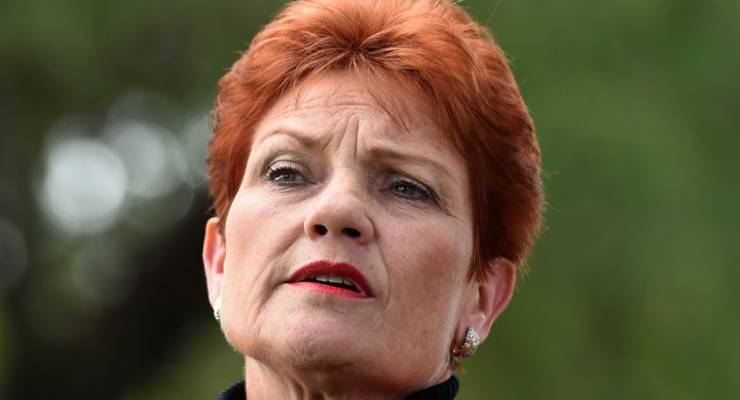
Does the Australian media give more coverage to right-wing politicians than left or centrist ones? In the wake of the announcement of the new Senate last month, it seemed like Malcolm Roberts was everywhere; with appearances on Insiders, Q&A and Lateline, it’s been hard to miss the surprise Senator from Queensland. In the policy vacuum left by the government, the media looked to the new motley collection of crossbenchers, who were ready and willing to take the call. And now that he and Pauline Hanson have made their maiden speeches, the media coverage will blossom even further.
After Roberts was elected second after Pauline Hanson in the Sunshine State, he didn’t waste any time making his views about climate change or Islam known to the public. But in a sample period analysed by Crikey and Isentia, Roberts had more interviews than all his fellow One Nation colleagues combined — even the party’s leader, Pauline Hanson. Some crossbenchers had not been interviewed even once on radio or television, with barely any other mentions in the media. So do Malcolm Roberts and Pauline Hanson’s views get overstated when they get more airtime? Is it a good idea to give such prominence to someone who thinks that NASA is cooking climate change statistics or someone who announces that we are being “swamped by Muslims”?
Malcolm Roberts: the One Nation climate denier too out there for Andrew Bolt
Analysis by Isentia of the first few weeks since the Senate was confirmed shows that Nick Xenophon has had more media appearances than any other crossbencher, which is unsurprising, considering that the Senator has been in this game for a while and is particularly talented at creating a good headline or voice grab.
After quite a gap, returning Liberal Democratic Senator David Leyonhjelm had the second highest number of interviews of the crossbenchers, although Pauline Hanson has been mentioned more in the media overall (this analysis covers the dates from August 4 — when the final states’ senators were confirmed — through to August 17. Some senators had been confirmed as elected before the fourth, meaning that their flurry of attention was over before this dataset.)

There is, of course, a commercial reality to measuring the number of times senators are invited on air by media outlets to spout their views. Xenophon, Leyonhjelm and Hinch are articulate and, in the case of Hinch and Xenophon, follow many populist causes. Roberts, Hanson and Jacqui Lambie have the lure of saying something outrageous, garnering more attention for the media outlet that has the grab of whatever is said.
While the Hansonites have been given a lot of attention, the members of Nick Xenophon’s team who aren’t Nick Xenophon have flown under the radar, and could probably walk down the halls of Parliament without troubling the media too much — but is this a good thing? Their votes have just as much weight as Malcolm Roberts’, and their views on climate change might even be based on science.

This chart shows that Nick Xenophon’s offsiders rated barely a mention, while their crossbench colleagues are everywhere in comparison. Will the interviews and mentions continue at this rate as Parliament continues? Or will the shininess of the new playthings wear off for the media in the coming weeks?








Well Sally, seeing as you were the fourth article in today’s edition of Crikey to talk about Pauline Hanson, I would say that’s a safe YES.
Indubitably, Q.E.D.
I’m amused at how much of our media seems amazed at how differently Hanson is being treated/indulged by the Turbott party in particular?
(Even Howard is advocating treating her differently to how he did? Then again it would be a little more difficult, these days to dispatch Toady, to hole her below the water line, in order to salvage her policies and believers (leaking votes from the Coal-ition) to benefit Limited News Party?)
Seemingly oblivious of recent history – not least the results of this business management wizard, Turbott’s, cunning plan to call a DD election to rid the senate stables of detritus, that resulted in Hanson’s return with 3 sprogs …. that Turbott is reliant upon to pass his legislation?
And re that “managerial pedigree”? What a great dividend return for risk was his ABCC DD – without it we wouldn’t have the prospect of more fun than a barrel of monkeys this new senate promises with these extra Hansonites? Then there was his pre-election warning that it would be a waste to vote for these “fringe-dwellers” that couldn’t deliver – where’s the pork-barrel being taken now, while they’ve got his balls? And, as he said in defence of the bullet holes in his feet, what a great, “truly representative” senatorial outcome we have as a result of that cunning plan – in this diverse selection of senators – so can we look forward to the next being a DD as well?
She is picking up here $2.40+ for each first preference vote for not much cost. Another outrageous statement another media frenzy. Why should she change a dam good money making model.